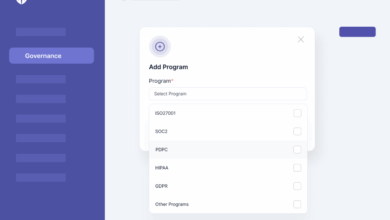
Amazon Web Services Launches European Sovereign Cloud
Amazon Web Services launches European sovereign cloud – a game-changer for European businesses! This monumental launch addresses the growing need for data sovereignty and compliance within the EU. It promises enhanced security, improved data residency, and a whole new level of control for organizations operating within Europe’s complex regulatory landscape. Get ready to dive into the details and discover how this could impact your business.
This new cloud offering isn’t just another AWS region; it’s a carefully crafted solution designed to meet the stringent data protection requirements of the EU. We’ll explore the architecture, security features, and compliance certifications that make it stand out. We’ll also look at how it stacks up against other AWS regions and competing cloud providers, examining pricing models and potential cost savings.
Ultimately, we’ll see how various industries can leverage this technology to streamline operations and achieve greater efficiency.
AWS European Sovereign Cloud
AWS’s launch of its European Sovereign Cloud represents a significant step towards addressing the growing demand for data sovereignty and control within the European Union. This new cloud infrastructure offers a compelling alternative for organizations seeking to comply with stringent EU data protection regulations while still benefiting from the power and scalability of the AWS cloud platform. This post delves into the specifics of this important development.
AWS European Sovereign Cloud Architecture
The AWS European Sovereign Cloud is built upon a foundation of geographically distributed data centers located within the European Union. This ensures that customer data remains within EU borders, fulfilling the residency requirements of various data protection regulations. The architecture leverages AWS’s proven global infrastructure, adapting it to meet the unique demands of sovereign cloud environments. This includes robust security measures, built-in redundancy, and high availability features designed to maintain data integrity and business continuity.
The specific locations of the data centers are strategically chosen to optimize performance and latency for users across Europe. Furthermore, the infrastructure is designed to be scalable, allowing businesses to easily adapt their cloud resources to meet evolving needs.
Key Features and Functionalities
The European Sovereign Cloud offers a comprehensive suite of AWS services, tailored to meet the needs of European organizations. Customers can leverage a wide range of compute, storage, database, and networking services, all while maintaining data residency within the EU. Key functionalities include: EC2 (Elastic Compute Cloud) for virtual servers, S3 (Simple Storage Service) for object storage, RDS (Relational Database Service) for managed databases, and VPC (Virtual Private Cloud) for secure network isolation.
Additionally, AWS offers a range of managed services, simplifying operations and reducing the burden on IT teams. This ensures that organizations can focus on their core business objectives, rather than managing complex infrastructure. The service is designed for seamless integration with existing on-premises systems, facilitating a smooth transition to the cloud.
Security and Compliance Certifications
Security and compliance are paramount for the European Sovereign Cloud. AWS has invested heavily in ensuring that the infrastructure meets the highest standards of data protection. The service is designed to comply with a wide range of regulations, including the General Data Protection Regulation (GDPR), ensuring customer data is handled responsibly and securely. Specific certifications include ISO 27001, ISO 27017, and ISO 27018, demonstrating AWS’s commitment to information security management.
Furthermore, AWS actively collaborates with regulatory bodies to ensure ongoing compliance with evolving standards. This commitment to security and compliance is a key differentiator for the European Sovereign Cloud, building trust and confidence amongst its users.
Comparison with Other AWS Regions
| Feature | European Sovereign Cloud | Other AWS Regions | Key Differences |
|---|---|---|---|
| Data Residency | Within the European Union | Varies by region | Guaranteed data location within EU borders for enhanced sovereignty |
| Compliance Certifications | GDPR, ISO 27001, ISO 27017, ISO 27018, and others | Varies by region and service | Focus on EU-specific regulations and certifications |
| Data Control | Enhanced control and governance features tailored for EU regulations | Standard AWS control mechanisms | Increased emphasis on customer control over data processing and access |
| Service Availability | Comprehensive suite of services, but potentially a more limited selection compared to global regions | Broadest range of AWS services | Trade-off between data sovereignty and access to the full range of AWS services |
Data Residency and Sovereignty Implications
The launch of AWS’s European Sovereign Cloud marks a significant shift in how businesses approach data storage and processing within the European Union. This service directly addresses the growing concerns around data sovereignty and compliance with stringent regulations like GDPR, offering a compelling alternative for organizations prioritizing data security and control. Understanding the implications of data residency within the EU is crucial for businesses navigating the complex landscape of international data protection laws.The European Sovereign Cloud addresses data sovereignty concerns by ensuring data remains within the EU’s geographical boundaries.
This means data is subject to EU laws and regulations, providing a higher level of control and compliance for businesses operating under GDPR and other relevant legislation. The service employs robust security measures and transparent data handling practices to maintain data integrity and protect against unauthorized access or breaches. This commitment to transparency and control significantly reduces the risk associated with data breaches and ensures compliance with regulatory requirements.
Data Residency and GDPR Compliance
The General Data Protection Regulation (GDPR) mandates that personal data of EU citizens must be processed in accordance with specific requirements, including data minimization, purpose limitation, and the right to be forgotten. The AWS European Sovereign Cloud is designed to fully comply with these requirements. Data processed within the sovereign cloud remains under the jurisdiction of EU law, simplifying compliance efforts for organizations and reducing the complexities associated with international data transfers.
This minimizes the legal and reputational risks associated with non-compliance. For example, a financial institution processing sensitive customer data can leverage the sovereign cloud to ensure complete compliance with GDPR, avoiding potential fines and reputational damage.
Benefits of a Sovereign Cloud for European Organizations
Utilizing a sovereign cloud offers numerous benefits to organizations operating within Europe. Enhanced data security and control are paramount, reducing the risk of data breaches and unauthorized access. Improved compliance with EU regulations like GDPR streamlines operations and mitigates legal risks. Furthermore, it fosters trust with customers and stakeholders, demonstrating a commitment to data privacy and security.
The increased control over data also enables organizations to better manage their data lifecycle and implement more effective data governance strategies. This translates to reduced operational costs in the long run due to improved efficiency and minimized compliance-related issues. For instance, a healthcare provider storing sensitive patient data can significantly reduce its compliance burden and strengthen patient trust by utilizing the sovereign cloud.
Comparison with Other Cloud Providers in Europe
While other cloud providers operate within Europe, the AWS European Sovereign Cloud distinguishes itself through its explicit commitment to data sovereignty. The key differentiator lies in the location of data storage and processing, ensuring that data remains within the EU’s jurisdictional boundaries. This contrasts with some providers who might store data in data centers outside the EU, potentially complicating compliance with GDPR and other regulations.
The level of transparency and control offered by the sovereign cloud also surpasses many existing offerings, providing businesses with a greater sense of security and control over their data. This enhanced control allows for more precise management of data access and usage, aligning with the principles of data minimization and purpose limitation central to GDPR. For example, a comparison could be drawn between the AWS European Sovereign Cloud’s data residency guarantees and the practices of other providers, highlighting the difference in control and compliance afforded to the user.
Target Audience and Use Cases

The AWS European Sovereign Cloud offers a compelling proposition for organizations prioritizing data residency, compliance, and control within the European Union. Its appeal extends across numerous sectors, each with unique needs and opportunities for leveraging this enhanced cloud infrastructure. Understanding these diverse use cases is crucial for appreciating the platform’s true potential.The benefits of the AWS European Sovereign Cloud extend far beyond simple data storage.
It provides a foundation for building secure and compliant applications, fostering innovation while adhering to stringent European regulations. This allows organizations to fully embrace cloud technologies without compromising their commitment to data sovereignty.
Financial Services Organizations
Financial institutions are subject to rigorous data protection regulations like GDPR and PSD2. The AWS European Sovereign Cloud offers a solution that helps these organizations meet these requirements while maintaining operational efficiency. For example, a large bank could use the service to store sensitive customer data, ensuring compliance while facilitating advanced analytics and fraud detection capabilities. Another use case could involve a fintech startup developing a new payment processing system, leveraging the cloud’s scalability and security to rapidly expand its operations while adhering to stringent regulatory demands.
The enhanced security and control offered by the sovereign cloud minimizes risk and strengthens customer trust.
Healthcare Providers and Research Institutions
The healthcare sector deals with extremely sensitive patient data, necessitating robust security and compliance measures. The AWS European Sovereign Cloud enables healthcare providers to securely store and process electronic health records (EHRs), facilitating better patient care and streamlined workflows. Research institutions can utilize the platform for collaborative research projects involving sensitive genomic data, benefiting from the secure and compliant environment.
Imagine a large hospital network consolidating its patient data onto the AWS European Sovereign Cloud, improving data accessibility for clinicians while ensuring complete compliance with HIPAA and GDPR regulations.
Government Agencies and Public Sector Organizations
Government agencies handle vast amounts of sensitive citizen data, demanding the highest levels of security and compliance. The AWS European Sovereign Cloud provides a secure and trustworthy environment for storing and processing this data, while also ensuring adherence to national and EU regulations. For example, a national tax agency could leverage the platform to manage tax records securely and efficiently, while a local government could use it to securely manage citizen services and infrastructure data.
The platform’s robust security features and compliance certifications build public trust and enhance the transparency of government operations.
Manufacturing and Industrial Companies
Manufacturing and industrial companies generate large volumes of operational data, often including sensitive intellectual property. The AWS European Sovereign Cloud provides a secure environment for storing and processing this data, enabling advanced analytics and predictive maintenance capabilities. For example, a large automotive manufacturer could use the service to store and analyze data from connected vehicles, improving product development and enhancing customer service.
Similarly, a smart factory could utilize the platform to manage and analyze sensor data from its production lines, optimizing efficiency and reducing downtime. The platform’s scalability allows for growth and adaptation as the company’s data volume increases.
Amazon Web Services launching a European sovereign cloud is huge news for data security and compliance. This move opens up exciting possibilities for application development, especially considering the advancements in low-code/no-code platforms. For developers looking to leverage these advancements, check out this insightful article on domino app dev the low code and pro code future to see how it all fits together.
Ultimately, this AWS launch will likely accelerate innovation within the EU, making such development strategies even more critical.
Pricing and Cost Considerations
Navigating the cost landscape of AWS’s European Sovereign Cloud requires a careful understanding of its pricing model and the factors influencing overall expenditure. While offering enhanced security and data residency, this service may present different cost implications compared to standard AWS regions. Let’s delve into the specifics.
The AWS European Sovereign Cloud pricing model isn’t a simple, single-rate system. It’s built upon the same pay-as-you-go structure as other AWS services, but with some key distinctions. Costs are calculated based on the specific services utilized, their consumption levels, and the region selected within the sovereign cloud infrastructure. This means you’ll be paying for compute, storage, databases, networking, and other services individually, just as you would in a standard AWS region.
However, the pricing for these individual services
-might* differ slightly from those in standard regions, reflecting the added security and compliance measures involved.
Factors Influencing Cost
Several factors significantly impact the total cost of leveraging the AWS European Sovereign Cloud. These factors should be carefully considered during planning and budgeting.
Understanding these cost drivers is crucial for accurate budgeting and resource optimization. Ignoring these factors could lead to unexpected expenses.
- Service Usage: The primary cost driver is the volume of services consumed. Higher compute power, larger storage needs, and increased data transfer all directly translate to higher costs.
- Region Selection: While all regions within the European Sovereign Cloud are designed to meet the same sovereignty requirements, there might be subtle variations in pricing between them, reflecting local infrastructure costs and market dynamics.
- Data Transfer Costs: Moving data into and out of the sovereign cloud will incur costs, particularly for large datasets. Efficient data management strategies are essential to minimize these expenses.
- Reserved Instances (RIs) and Savings Plans: Similar to standard AWS regions, utilizing RIs or Savings Plans can lead to significant cost savings by committing to a certain level of usage upfront. However, careful planning is needed to avoid over-commitment.
- Compliance and Security Features: The enhanced security and compliance features built into the European Sovereign Cloud might slightly influence pricing compared to standard regions, though AWS doesn’t explicitly state a premium for these aspects. However, the indirect savings from reduced risk and compliance-related costs should be factored in.
Cost Comparison Scenario
Let’s consider a hypothetical e-commerce company, “EuroShop,” processing sensitive customer data from across Europe.
A cost comparison between using the AWS European Sovereign Cloud and a standard AWS region in Ireland (a commonly used region for European businesses) needs to consider the specific services EuroShop will use. Let’s assume their core services include compute (EC2 instances), storage (S3), and a database (RDS).
| Service | European Sovereign Cloud (Estimated) | Standard AWS Region (Ireland) (Estimated) |
|---|---|---|
| Compute (EC2 – 10 instances, 1 year) | €10,000 | €9,000 |
| Storage (S3 – 1TB, 1 year) | €500 | €400 |
| Database (RDS – Medium instance, 1 year) | €2,000 | €1,800 |
| Data Transfer | €500 | €300 |
| Total Estimated Annual Cost | €13,000 | €11,500 |
This example demonstrates a potential increase in cost when using the European Sovereign Cloud. However, it’s crucial to note that this is a simplified scenario. The actual cost difference will depend on the specific services used, their usage levels, and the chosen pricing models (e.g., RIs, Savings Plans).
Competitor Pricing Comparison
Direct price comparisons with competitors offering similar sovereign cloud solutions are difficult due to the variations in service offerings and the lack of publicly available detailed pricing information from competitors. However, a general observation is that sovereign cloud solutions tend to be priced at a premium compared to standard public cloud offerings, reflecting the higher infrastructure costs and enhanced security measures.
The value proposition lies in the enhanced compliance, reduced regulatory risk, and data sovereignty guarantees, which can significantly outweigh the higher direct costs for organizations with stringent data residency requirements.
Technical Aspects and Integration: Amazon Web Services Launches European Sovereign Cloud
Migrating to the AWS European Sovereign Cloud involves more than just moving data; it’s a strategic shift demanding careful planning and execution. Successful integration hinges on understanding your existing infrastructure, application dependencies, and the unique capabilities of the sovereign cloud environment. This section delves into the technical aspects, offering practical guidance for a smooth transition.
Application and Data Migration Process
The migration process typically involves several phases. First, a thorough assessment of your existing applications and databases is crucial. This involves identifying dependencies, assessing compatibility with AWS services offered within the European Sovereign Cloud region, and determining the optimal migration strategy (rehosting, refactoring, re-platforming, repurchase, or retiring). Next, a phased migration approach is recommended, starting with non-critical applications to test and refine the process before moving mission-critical systems.
Data migration requires careful planning to ensure data integrity and compliance with data sovereignty regulations. Tools like AWS Database Migration Service (DMS) can facilitate this process, although its availability within the European Sovereign Cloud region needs to be verified. Finally, rigorous testing and validation are essential to confirm functionality and performance after the migration.
Technical Requirements and Considerations, Amazon web services launches european sovereign cloud
Successful integration requires careful consideration of several technical factors. Network connectivity is paramount, ensuring secure and reliable communication between your on-premises infrastructure and the AWS European Sovereign Cloud. Compliance with data residency and sovereignty regulations is another critical aspect. This necessitates understanding the specific data localization requirements and configuring your applications and services accordingly. Security best practices must be implemented throughout the migration process, including robust access control, encryption, and regular security audits.
Finally, performance optimization is key to ensuring the smooth operation of your applications in the new environment. This may involve adjusting application configurations, optimizing database queries, and utilizing AWS services designed for performance enhancement. For example, consider using AWS’s caching services to reduce latency.
Connecting to and Managing Resources via the AWS Management Console
Accessing and managing resources within the AWS European Sovereign Cloud is done through the familiar AWS Management Console. However, it’s crucial to ensure you are logged into the correct region (the European Sovereign Cloud region) to access the relevant resources. The console provides a comprehensive interface for managing various services, including EC2 instances, S3 buckets, databases, and networking components.
IAM (Identity and Access Management) plays a vital role in controlling access to resources, allowing you to define granular permissions for users and applications. Using IAM roles and policies, you can restrict access to specific resources and actions, enhancing security and compliance. The console also provides monitoring and logging capabilities, allowing you to track resource usage, identify performance bottlenecks, and monitor security events.
Setting Up a Simple Application on the European Sovereign Cloud
Let’s Artikel setting up a basic web application using Amazon EC2. First, launch an EC2 instance in the European Sovereign Cloud region, choosing an appropriate Amazon Machine Image (AMI) for your application. Next, configure the instance’s security group to allow inbound traffic on the required ports (e.g., port 80 for HTTP). Then, connect to the instance using SSH and install the necessary software and dependencies for your application.
Finally, deploy your application code to the instance and verify its functionality. This process might involve using tools like Git for code deployment and systemd for managing services. Remember, all actions must adhere to the security and compliance guidelines established for the European Sovereign Cloud environment. For example, ensure data encryption is used where appropriate.
Illustrative Scenario
Let’s imagine a fictional European company, “GreenTech Solutions,” a rapidly growing renewable energy firm based in Berlin, Germany. They develop and maintain software for smart grids, managing the flow of energy from various renewable sources. GreenTech faces challenges in meeting stringent European data privacy regulations (GDPR) while scaling its operations and ensuring data sovereignty. Their existing cloud infrastructure, hosted outside the EU, presents significant compliance and security risks.GreenTech Solutions’ primary concern is maintaining the confidentiality, integrity, and availability of sensitive data related to energy consumption, grid stability, and customer information.
They need a solution that guarantees data residency within the EU, allowing them to comply with GDPR and other relevant regulations while maintaining a cost-effective and scalable cloud infrastructure.
GreenTech’s Solution with AWS European Sovereign Cloud
GreenTech decides to migrate its core infrastructure to the AWS European Sovereign Cloud. This allows them to store and process all sensitive data within EU borders, ensuring compliance with GDPR and other relevant data sovereignty laws. The migration process involves a phased approach, starting with less critical applications and gradually moving core systems.
Data Security and Compliance Measures
GreenTech implements robust security measures, leveraging AWS’s built-in security features within the sovereign cloud environment. This includes utilizing encryption at rest and in transit, implementing strong access controls using IAM roles and policies, and regularly monitoring security logs for suspicious activity. They also implement data loss prevention (DLP) measures to prevent sensitive information from leaving the controlled environment. Regular security audits are conducted to ensure ongoing compliance with relevant regulations.
The AWS sovereign cloud’s certifications and compliance attestations significantly reduce their compliance burden.
Cost Savings and Operational Efficiency
By migrating to the AWS European Sovereign Cloud, GreenTech benefits from a pay-as-you-go model, allowing them to optimize their cloud spending based on actual usage. They eliminate the need for significant upfront investments in hardware and infrastructure maintenance. The improved scalability and elasticity of the AWS cloud also allow them to quickly adapt to changing business demands, avoiding costly over-provisioning.
The streamlined management tools offered by AWS further contribute to operational efficiency and reduced IT overhead. For example, their previous infrastructure required three dedicated IT staff members for maintenance, while AWS’s managed services allow them to reduce this to one.
Results Achieved
The transition to the AWS European Sovereign Cloud has enabled GreenTech Solutions to significantly improve its data security posture and meet all relevant regulatory requirements. They’ve experienced increased operational efficiency, reduced IT costs, and enhanced scalability to support their rapid growth. The improved security and compliance have also enhanced their reputation and strengthened customer trust. Specifically, their IT operational costs were reduced by approximately 20% within the first year, while simultaneously achieving a 15% increase in developer productivity.
This enabled GreenTech to accelerate the development of new features and expand into new markets.
Last Recap

The launch of the AWS European Sovereign Cloud marks a significant step towards greater data control and compliance for European businesses. By addressing key concerns around data residency and sovereignty, AWS empowers organizations to confidently embrace the cloud while adhering to stringent EU regulations. Whether you’re a small startup or a large enterprise, understanding the implications of this launch is crucial for navigating the future of cloud computing in Europe.
So, are you ready to explore the possibilities?
Common Queries
What specific EU regulations does the AWS European Sovereign Cloud comply with?
It’s designed to meet the requirements of GDPR and other relevant EU data protection laws. Specific compliance certifications will vary and should be verified on the AWS website.
How much does the AWS European Sovereign Cloud cost?
Pricing is based on usage, similar to other AWS regions, but specific costs will depend on your needs. Check the AWS pricing calculator for detailed estimates.
What if I already have applications running in another AWS region? How easy is it to migrate?
AWS provides various migration tools and services to help with the transition. The complexity will depend on the size and complexity of your applications. AWS support can provide guidance on this process.
What types of support are available for the European Sovereign Cloud?
AWS offers various support plans, ranging from basic to enterprise-level support, similar to its other regions. Details can be found on the AWS support website.




